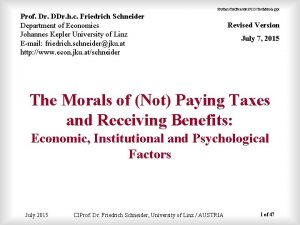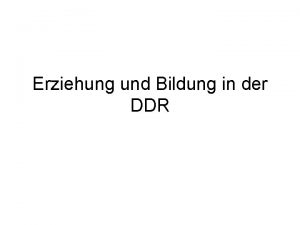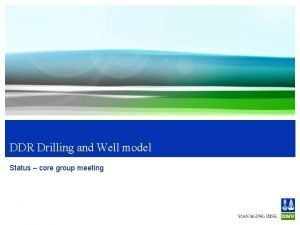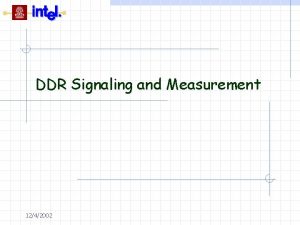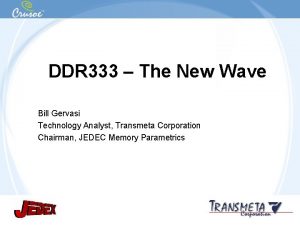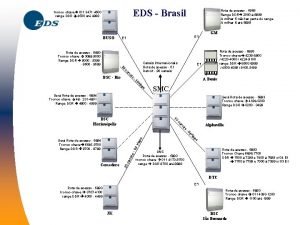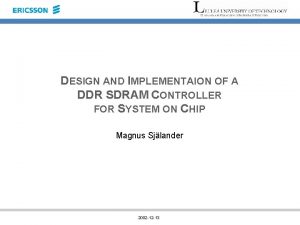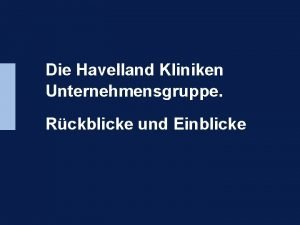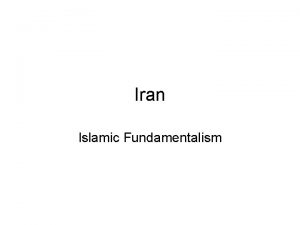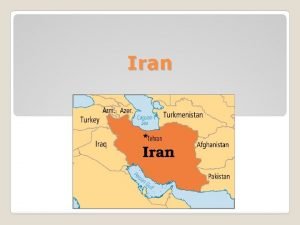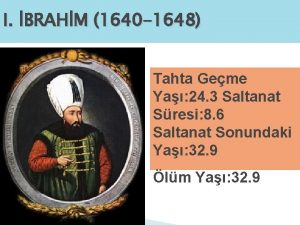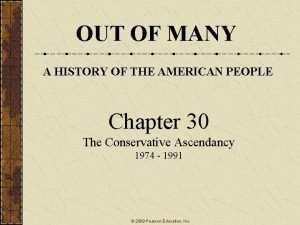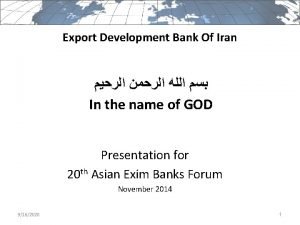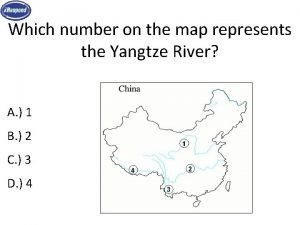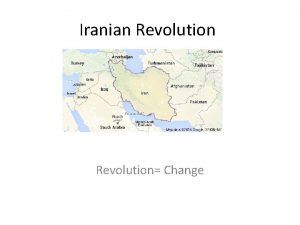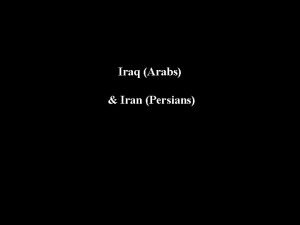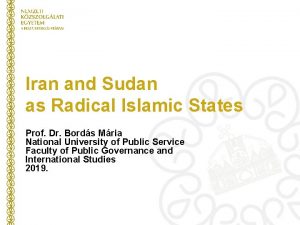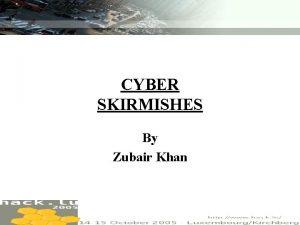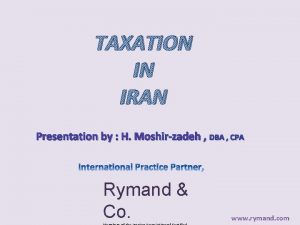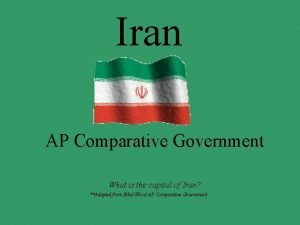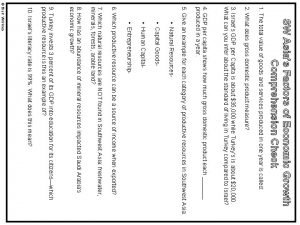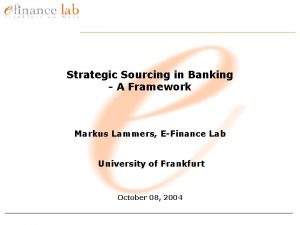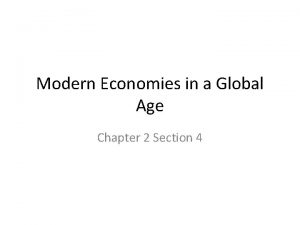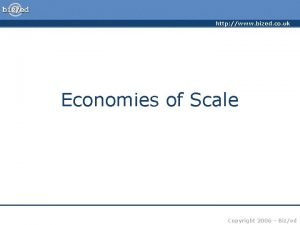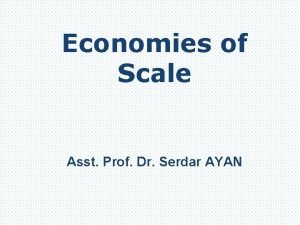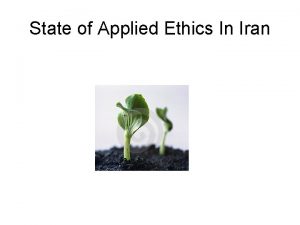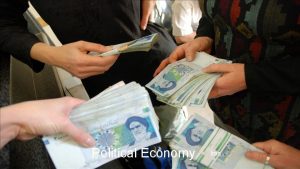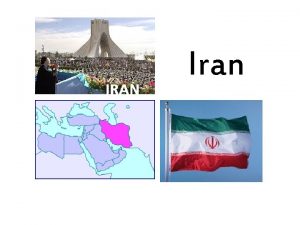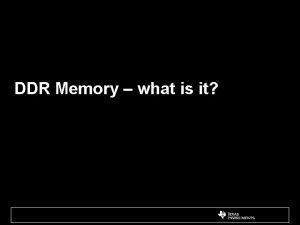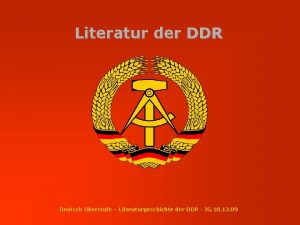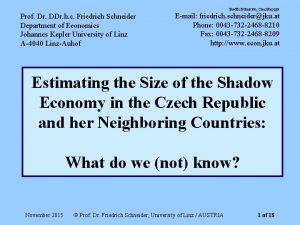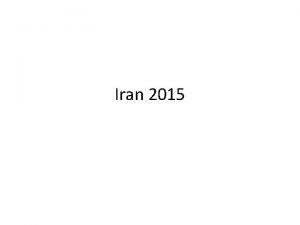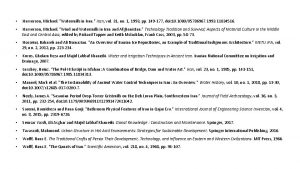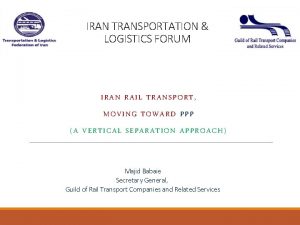StudienPfusch NEU2018Shadow Economies Iran ppt Prof Dr DDr




























































- Slides: 60

StudienPfusch. NEU2018Shadow. Economies. Iran. ppt Prof. Dr. DDr. h. c. Friedrich Schneider E-mail: friedrich. schneider@jku. at http: //www. econ. jku. at September 2018 Revised Version SHADOW ECONOMIES IN IRAN, HER NEIGHBORS AND AROUND THE WORLD: WHAT DO WE (NOT) KNOW? September 2018 © Prof. Dr. Friedrich Schneider, University of Linz, Austria 1 of 45

CONTENT 1. Introduction 2. Theoretical Considerations 3. Estimation Methods 4. Empirical Results of the Size of the Shadow Economy 5. How do We Estimate Economies? – A résumé Shadow 6. Policy Measures September 2018 © Prof. Dr. Friedrich Schneider, University of Linz, Austria 2 of 45

1. INTRODUCTION (1) There are many political statements that tax evasion and the shadow economy are important and cause severe damage on the official economy and on public (tax) revenues. (2) Hence, the goal of this lecture has four goals: (i) To present the size and development of the shadow economy and of tax evasion in 158 countries all over the world. (ii) To present the size and development about the shadow economy in Iran and her neighbors (iii) To critically discuss the plausibility of the MIMIC-Macro- Estimates (iv) Finally, policy measures, to reduce the shadow economy are presented. September 2018 © Prof. Dr. Friedrich Schneider, University of Linz, Austria 3 of 45

1. INTRODUCTION Ø A shadow economy has many names, like cash, underground, grey or sometimes dark economy. There is no convention what the „correct“ name is. Ø A shadow economy is more or less a parallel economy meaning, that additional “shadow activities” are: neighbors or friends help, do-ityourself activities or family production (in general and) in the agricultural sector. Ø Hence, the consequence is, that using macro- methods quite often a “large” shadow economy is measured. September 2018 © Prof. Dr. Friedrich Schneider, University of Linz, Austria 4 of 45

2. THEORETICAL CONSIDERATIONS 2. 1 DEFINITIONS (1) The shadow economy includes all legal production and provision of goods and services that are deliberately concealed from public authorities for the following four reasons: (i) to avoid payment of income, value added or other taxes; (ii) to avoid payment of social security contributions; (iii) to avoid having to meet certain legal standards such as minimum wages, maximum working hours, etc. ; and (iv) to avoid complying procedures. September 2018 with certain administrative © Prof. Dr. Friedrich Schneider, University of Linz, Austria 5 of 45

2. THEORETICAL CONSIDERATIONS 2. 1 DEFINITIONS activities are all illegal actions that fit the characteristics of classical crime activities like smuggling, burglary, drug dealing, etc. (2) Underground (3) Informal household and do-it-yourself activities are household actions that are not registered officially under various specific forms of national legislation. These two activities should not be included in the shadow economy activities, but to some extent they are. (4) Tax evasion is under- (or not) reporting capital and/or labor income, domestic or abroad. September 2018 © Prof. Dr. Friedrich Schneider, University of Linz, Austria 6 of 45

2. THEORETICAL CONSIDERATIONS 2. 2 THEORIZING ABOUT THE SHADOW ECONOMY AND TAX EVASION What are the main causes determining the size of the shadow economy and of tax evasion? (i) Tax and social security contribution burdens; (ii) Intensity of regulations; (iii) Public Sector Services; (iv) Tax morale; (v) Unemployment; (vi) Self-employment; (vii) Size of the agricultural sector; (viii) Official income; (ix) Quality of public institutions; (x) Federal (direct democratic) system What are the main indicators, in which shadow economy activities are reflected? (i) Official GDP; (ii) Cash; (iii) Official Employment September 2018 © Prof. Dr. Friedrich Schneider, University of Linz, Austria 7 of 45

2. THEORETICAL CONSIDERATIONS 2. 3 PROBLEM OF DOUBLE COUNTING All ten cause factors, but especially (i) tax burden, (ii) regulation, (iii) unemployment, (iv) self-employment, (v) and size of the agricultural sector are also major driving forces for smuggling, neighbours help. do-it-yourself activities and Hence, in the MIMIC and Currency Demand Estimations these activities are (at least) partly included; hence, these estimates are higher than the „true“ shadow economy estimates. September 2018 © Prof. Dr. Friedrich Schneider, University of Linz, Austria 8 of 45

3. ESTIMATION METHODS THREE ESTIMATION PROCEDURES (1) Direct procedures using the micro level and aiming at determining the size of the shadow economy. Quite often this method is done by surveys and by “calculating” discrepancies in National Accounts. (2) Indirect procedures that make use of macroeconomic indicators proxying the development of the shadow economy over time; e. g. the currency demand approach. (3) Statistical models that use statistical tools to estimate the shadow economy as an “unobserved” or “latent” variable; e. g. the MIMIC (Multiple Indicator, Multiple Causes) Method. September 2018 © Prof. Dr. Friedrich Schneider, University of Linz, Austria 9 of 45

3. ESTIMATION METHODS 3. 1 DIRECT APPROACHES – GENERAL REMARKS (1) These are microeconomic approaches that employ either well designed surveys or samples based on voluntary replies or tax auditing and other compliance methods. (2) Estimates of the shadow economy can also be based on the discrepancy between income declared for tax purposes and the actual detected one by audits. Advantage of methods (1) and (2): Detailed knowledge about the shadow economy on an individual basis. September 2018 © Prof. Dr. Friedrich Schneider, University of Linz, Austria 10 of 45

3. ESTIMATION METHODS 3. 1 DIRECT APPROACHES: (I) USE OF SURVEYS OF COMPANY MANAGERS (3) Use of surveys of company managers and miss reported business income (Putnins and Sauka, 2015): (i) They combine miss reported business income and miss reported wages as percentage of GDP. (ii) Their method produces detailed information on the structure of the shadow economy, especially in the firm sector. (iii) It is based on the facts that company managers know how much business income and wages go unreported due to their unique position in dealing both of these types of income. (iv) Their method combines estimates of miss reported business incomes, unregistered or hidden employees, and unreported wages in order to calculate a total estimate of the size of the shadow economy. September 2018 © Prof. Dr. Friedrich Schneider, University of Linz, Austria 11 of 45

3. ESTIMATION METHODS 3. 1 DIRECT APPROACHES: (II) MODIFIED CONSUMPTIONINCOME GAP METHOD (4) Modified household data for the estimation of a shadow economy: Consumption – Income Gap - method: (i) The size of the shadow economy was estimated by Lichard, Hanousek and Filer (2014) based on microeconomic data without making the unrealistic assumptions which leads to under-estimating the size of the shadow economy by excluding underreporting among those who unjustifiably assumed to fully report their income. (ii) The logical explanation is that employees being paid under the table or having a secondary, undeclared, source of income while not being officially classified as “selfemployed” constitute a major source of unreported income, which is included in their approach. September 2018 © Prof. Dr. Friedrich Schneider, University of Linz, Austria 12 of 45

3. ESTIMATION METHODS 3. 1 DIRECT APPROACHES: (III) NATIONAL ACCOUNTS METHOD Figure 3. 1: Classification of NOE (non-observed economy) Is the producer in scope of administrative collection or an enterprise survey? YES It is correctly handled? NO Is the producer administratively registered? YES N 4 – registered legal person N 5 – registered entrepreneur not reached in the statistics N 1 Producer should have registered, but it has not (underground producer) NO Obligation to register? N 2 Illegal Producer YES N 6 Producer misreporting NO N 7 Deficiencies in the statistical system (incorrect surveying or survey handling) N 3 No obligation to register Source: Van de Ven (2017), Power. Point Presentation, OECD Paris, p. 8. September 2018 © Prof. Dr. Friedrich Schneider, University of Linz, Austria 13 of 45

3. ESTIMATION METHODS 3. 1 DIRECT APPROACHES: (III) NATIONAL ACCOUNTS METHOD Concept of the NOE: (1) Non-observed economy categories: Ø Economic underground: N 1+N 6 (non-registered producers + misreporting) Ø Informal (and own account production): N 3+N 4+N 5 (no obligation to register, registered legal person and registered entrepreneur not reached in the statistics) Ø Statistical underground: N 7 (deficiencies in the statistical system) Ø Illegal: N 2 (illegal producers) Source: Van de Ven (2017) September 2018 © Prof. Dr. Friedrich Schneider, University of Linz, Austria 14 of 45

3. ESTIMATION METHODS 3. 1 DIRECT APPROACHES: (III) NATIONAL ACCOUNTS METHOD Table 3. 1: NOE adjustments by informality type – percentage of GDP (share of adjustment type within total NOE); 2011– 2012 Austria Belgium Canada Czech Rep. France Hungary Israel Italy Mexico Netherlands Norway Poland Slovak Rep. Slovenia Sweden U. K. Underground N 1 + N 6 Illegal N 2 2. 4 (31. 7%) 3. 8 (83. 8%) 1. 9 (88. 2%) 6. 3 (77. 6%) 3. 7 (54. 7%) 3. 1 (27. 9%) 2. 2 (32. 6%) 16. 2 (92. 8%) 5. 5 (34. 7%) 0. 8 (36. 6%) 0. 5 (51. 5%) 12. 7 (82. 6%) 12. 1 (77. 3%) 3. 9 (38. 2%) 3 (100%) 1. 5 (65. 6%) 0. 2 (2. 1%) 0. 2 (8. 2%) 0. 4 (4. 5%) 0. 8 (7. 5%) 0. 5 (20. 1%) 0 (0. 3%) 0. 9 (6%) 0. 5 (3%) 0. 3 (3. 2%) Informal sector N 3 + N 4 + N 5 1. 5 (19. 4%) 1. 3 (15. 6%) 2. 9 (42. 7%) 3. 1 (28. 6%) 1. 4 (21. 8%) Statistical deficiencies N 7 3. 5 (46. 8%) 0. 7 (16. 2%) 0. 1 (3. 6%) 0. 2 (2. 3%) 0. 2 (2. 7%) 3. 9 (36%) 3 (45. 6%) 1. 2 (7. 2%) 10. 4 (65. 3%) 0. 5 (20%) 0. 5 (43. 8%) 0 (0%) 2. 9 (18. 7%) 2. 8 (27. 7%) 0. 5 (23. 2%) 0 (4. 4%) 1. 8 (11. 4%) 0. 2 (1%) 3. 1 (30. 9%) 0. 5 (22. 9%) 0. 3 (11. 4%) Total NOE 7. 5 (100%) 4. 6 (100%) 2. 2 (100%) 8. 1 (100%) 6. 7 (100%) 10. 9 (100%) 6. 6 (100%) 17. 5 (100%) 15. 9 (100%) 2. 3 (100%) 15. 4 (100%) 15. 6 (100%) 10. 2 (100%) 3 (100%) 2. 3 (100%) Source: Van de Ven (2017), Power. Point Presentation, OECD Paris, p. 15. September 2018 © Prof. Dr. Friedrich Schneider, University of Linz, Austria 15 of 45

3. ESTIMATION METHODS 3. 2 THE CURRENCY DEMAND APPROACH Basic regression equation for the currency demand from Tanzi (1983): ln (C / M 2)t = b 0 + b 1 ln (1 + TW)t + b 2 ln (WS / Y)t + b 3 ln Rt + b 4 ln (Y / N)t + ut with b 1 > 0, b 2 > 0, b 3 < 0, b 4 > 0, where ln denotes natural logarithms, C / M 2 ratio of cash holdings to deposit accounts, TW average tax rate (to proxy changes of the shadow economy), September 2018 © Prof. Dr. Friedrich Schneider, University of Linz, Austria 16 of 45

3. ESTIMATION METHODS 3. 3 The Multiple Indicators Multiple Causes (MIMIC) Approach: Ø Modeling the shadow economy as an unobservable (latent) variable; Ø Description of the relationships between the latent variable and its causes in a structural model: Ø Link between the latent variable and its indicators is represented in the measurement model: η: latent variable (shadow economy) X: (q× 1) vector of causes in the structural model Y: (p× 1) vector of indicators in the measurement model Γ: (1×q) coefficient matrix of the causes in the structural equation Λ y: (p× 1) coefficient matrix in the measurement model ζ, ε: errorterminthestructuralmodelandεisa(p× 1)vectorofmeasurement error in y September 2018 © Prof. Dr. Friedrich Schneider, University of Linz, Austria 17 of 45

3. ESTIMATION METHODS Figure 3. 1: Path diagram of the MIMIC model 1) Causes: Share of Direct taxation Share of Indirect taxation and of social security contribution Indicators: + - + Shadow + Burden of state regulation Economy + + Tax morale + Unemployment quota GDP per capita (in US$) - - Employment quota ε 1 Average working time (per week) ε 2 Change of local currency per capita ε 3 The estimations of the currency demand method for single countries will be used to transform the ordinal shadow economy indices into cardinal values of shadow economy. 1) September 2018 © Prof. Dr. Friedrich Schneider, University of Linz, Austria 18 of 45

3. ESTIMATION OF THE SHADOW ECONOMY – 3. 5 EMPIRICAL RESULTS Table 3. 2: MIMIC Model Estimation Results: 1991 -2015, 158 Countries (Part 1) 1 2 3 4 5 6 Causes Trade Openness -0. 086*** -0. 085*** -0. 137*** -0. 086*** -0. 113*** GDP per Capita -0. 332*** -0. 335*** -0. 37*** Unemployment Rate 0. 051** 0. 054*** 0. 069*** Size of Government 0. 102*** 0. 111*** Fiscal Freedom Rule of Law Control for Corruption -0. 298*** -0. 302*** -0. 334*** 0. 053** 0. 057*** 0. 069*** -0. 131*** -0. 134*** -0. 147*** -0. 049*** -0. 06*** -0. 042*** Government Stability -0. 046** -0. 054*** -0. 015 Source: Own calculations. Note: *** p<0. 01, ** p<0. 05, * p<0. 1 September 2018 © Prof. Dr. Friedrich Schneider, University of Linz, Austria 19 of 45

3. ESTIMATION OF THE SHADOW ECONOMY – 3. 5 EMPIRICAL RESULTS Table 3. 3: MIMIC Model Estimation Results: 1991 -2015, 158 Countries (Part 2) 1 2 3 4 5 6 1 1 1 Indicators Currency Labor Force Participation Rate -0. 521*** -0. 532*** Growth of GDP p. c. -0. 208** -0. 31*** -0. 245*** -0. 386*** -0. 452*** -0. 468*** -0. 249*** -0. 113 -0. 144* -0. 157*** Statistical Tests RMSEA 0. 073 0. 067 0. 078 0. 055 Chi-square 5. 13 5. 06 6. 49 5. 08 5. 06 5. 35 Observations 1897 1892 2350 1758 1757 1998 Countries 151 122 144 120 Source: Own calculations. Note: *** p<0. 01, ** p<0. 05, * p<0. 1 September 2018 © Prof. Dr. Friedrich Schneider, University of Linz, Austria 20 of 45

4. SIZE OF THE SHADOW ECONOMY Figure 4. 1: Shadow economy by region (average, percent of GDP) 50 1991 -99 45 2000 -09 2010 -14 40 33. 92 34. 19 33. 90 35 30 25 25. 11 23. 94 22. 14 26. 21 43. 39 42. 45 40. 82 40. 26 39. 87 37. 84 27. 38 24. 20 22. 60 24. 86 23. 09 20. 73 20 18. 56 17. 34 15 10 5 0 East Asia Middle East and North Africa (19 c. ) (18 c. ) Europe (37 c. ) South Asia (7 c. ) Sub-Saharan Africa (42 c. ) Latin America Caribean (24 c. ) OECD (34 c. ) Source: Own calculations. September 2018 © Prof. Dr. Friedrich Schneider, University of Linz, Austria 21 of 45

4. SIZE OF THE SHADOW ECONOMY Figure 4. 2: Size of the shadow economy in % of GDP of the 15 countries with the highest and the lowest shadow economy – Part I (highest); average over 1991 to 2015. Shadow economy in % of GDP 70 64. 9 62. 3 60. 6 60 56. 3 54. 7 54 53. 7 53. 3 52. 4 52. 2 51. 4 50. 6 50 46. 9 46. 8 40 30 20 10 ba i Ta jan nz a M nia ya nm Th ar a G am ilan d bi a, Th e B el iz e ru Pe ze r n A G ab o ti ai H a ve ra ge B en in al A em ia G ua t ig er e N bw ia ba m ol iv Zi B G eo rg i a 0 Source: Own calculations. September 2018 © Prof. Dr. Friedrich Schneider, University of Linz, Austria 22 of 45

4. SIZE OF THE SHADOW ECONOMY 18 16 14 15. 8 15. 6 15. 1 14. 7 14. 2 14. 1 12 10 13. 4 13. 3 12. 6 11. 9 11. 2 10. 8 10. 7 9. 9 9. 4 9 8 6 4 2 0 Ic el an G H er d on m g an K on y Vi et g SA na m R , C N et hin he a rla nd A us s N ew tra l U Ze ia ni te al an d K in d gd om A ve ra Si ge ng ap or e C hi na Lu Ja xe pa n m bo ur A g U ni ust te ria d S Sw tat itz es er la nd Shadow economy in % of GDP Figure 4. 3: Size of the shadow economy in % of GDP of the 15 countries with the highest and the lowest shadow economy – Part II (lowest); average over 1991 to 2015. Source: Own calculations. September 2018 © Prof. Dr. Friedrich Schneider, University of Linz, Austria 23 of 45

4. SIZE OF THE SHADOW ECONOMY Table 4. 1: Decomposition of the shadow economy activities in Estonia and Germany Kinds of shadow economy activities (rough estimates!) Estonia Germany Size in % of official GDP average 2009 -2015 Proportion of total shadow economy Size in % of official GDP average 2009 -2015 Proportion of total shadow economy 28. 0 100% 16. 2 100% (2) Legally bought material for shadow economy and DIY-activities 6. 0 21% 3. 1 19. 1% (3) Illegal activities (smuggling etc. ) 2. 0 7% 1. 2 7. 4% (4) Do-it-yourself activities and neighbours help 1) 2. 0 7% 1. 5 9. 2% (5) Sum (2) and (4) 10. 0 35% 5. 8 35. 7% (6) “Corrected” or “adjusted” shadow economy, but legal activities (position (1) minus position (5)) 18. 0 65% 10. 4 64. 2% (1) Total (makro) shadow economy (estimated by the MIMIC and calibrated by the currency demand procedures) 1) Without legally bought material which is included in (2) Source: Own calculations, Linz, September 2016. September 2018 © Prof. Dr. Friedrich Schneider, University of Linz, Austria 24 of 45

Table 4. 2: Size of the shadow economies of different country groups (Macro-MIMIC + adj. MIMIC) Country groups [adjusted values] No. of countries East Asia 19 Middle East and North Africa 18 Europe 37 South Asia 7 Sub-Saharan Africa 42 Latin America Caribean 24 OECD 34 Average over all countries 181 1) Unweighted averages Source: Own calculations. September 2018 Size of the shadow economy 1) Years Average 199120002010 over 1999 2009 2015 – 2015 25. 53 23. 86 21. 08 23. 49 [16. 59] [15. 51] [13. 70] [15. 27] 27. 31 24. 34 23. 81 25. 15 [17. 75] [15. 82] [15. 48] [16. 35] 28. 12 24. 79 22. 77 25. 23 [18. 28] [16. 11] [14. 80] [16. 40] 34. 75 32. 31 27. 58 31. 55 [22. 59] [21, 00] [17. 93] [20. 51] 42. 36 39. 98 36. 13 39, 49 [27. 53] [25. 99] [23. 48] [25. 67] 42. 29 39. 33 34. 80 38. 81 [27. 49] [25. 56] [22. 62] [25. 22] 21. 42 18. 84 18. 24 19. 5 [13. 92] [12. 25] [11. 86] [12. 68] 31. 68 29. 06 26. 34 29. 03 [20. 59] [18. 89] [17. 12] [18. 87] 25 of 45

4. SIZE OF THE SHADOW ECONOMY Figure 4. 4: Size of the Shadow Economy of 16 European Countries in 2017– macro and adjusted Shadow economy in % of GDP 18. 0 16. 6 15. 6 16. 0 14. 1 14. 0 13. 0 12. 0 10. 8 12. 2 12. 1 11. 5 10. 1 10. 4 9. 2 10. 0 10. 9 8. 5 8. 3 7. 9 8. 0 7. 9 8. 4 7. 5 7. 1 6. 8 8. 2 7. 1 6. 8 6. 1 5. 5 6. 0 5. 3 4. 6 3. 9 4. 0 2. 0 d Sw itz er la n ia tr us A bo ur g s xe m Lu er la nd m et h N in g K d te ni ze U C Source: Own calculations. do la nd y m an Ire k er G en m ar d D an nl Fi en ed Sw N or w ay ce an Fr a ov ak i lic R ch Sl ub ep gi el B Po rt ug al um 0. 0 makro September 2018 adjusted © Prof. Dr. Friedrich Schneider, University of Linz, Austria 26 of 45

4. SHADOW ECONOMY Table 4. 3: Comparison of the MIMIC (macro and adjusted) with National Accounts Method; 16 OECD countries, years 2011/2012 (av. ) Nr. Country 1 2 3 4 5 6 7 8 9 10 11 12 13 14 15 16 Slovenia Norway Israel Belgium Mexico Hungary Sweden Canada Poland Czech Rep. UK Netherlands France Italy Slovak Rep. Austria NOE 1) (1) % of GDP 10. 2 1 6. 6 4. 6 15. 9 10. 9 3 2. 2 15. 4 8. 1 2. 3 6. 7 17. 5 15. 6 7. 5 MIMIC Macro (2) Adj. (3) 23. 9 15. 5 14. 5 9. 4 19. 7 12. 8 17 11 27. 9 18. 1 22. 6 14. 7 14. 5 9. 4 11. 7 7. 6 24. 7 16 16. 2 10. 5 10. 3 6. 7 9. 6 6. 2 10. 9 7. 1 21. 4 13. 9 15. 7 10. 2 7. 6 4. 9 Difference (MIMIC-NOE) (2)-(1) (3)-(1) 13. 7 5. 3 13. 5 8. 4 13. 1 6. 2 12. 4 6. 4 12 2. 2 11. 7 3. 8 11. 5 6. 4 9. 5 5. 4 9. 3 0. 6 8. 1 2. 4 8 4. 4 7. 3 3. 9 4. 2 0. 4 3. 9 -3. 6 0. 1 -5. 4 0. 1 -2. 6 1) NOE calculated by National Account Stat. using the discrepancy method. Source: Non observed economy OECD (2014): Papers; MIMIC: own calculations. September 2018 © Prof. Dr. Friedrich Schneider, University of Linz, Austria 27 of 45

4. SIZE OF THE SHADOW ECONOMY Table 4. 4: Comparison between National Accounts Statistics and MIMIC Results of 8 Sub. Saharan African countries over 2010 -2014 Methods (averages over 2010 -2014) Differences (1) National Accounts Statistics 1) (2) MIMIC (3) MIMIC Adjusted (2)-(1) (3)-(1) 53. 4 38 31. 8 -15. 4 -21. 6 Mali 55 40. 4 26. 3 -14. 6 -28. 7 Togo 40. 1 28 24. 7 -12. 1 -15. 4 Guinea 48. 1 37 24. 1 -11. 1 -24 Burkina Faso 43. 1 32 26 -11. 1 -17. 1 Senegal 47. 5 40 20. 8 -7. 5 -26. 7 Benin 55. 6 49 18. 2 -6. 6 -37. 4 34 35 22. 8 1 -37. 4 Country Guinea. Bissau Cote d’Ivoire Correlation: 0. 73 Spearman’s Rank Correlation: 0. 857*** 1) Discrepancy method Source: Medina et al. (2017), p. 28 September 2018 © Prof. Dr. Friedrich Schneider, University of Linz, Austria 28 of 45

4. SIZE AND DEVELOPMENT OF THE SHADOW ECONOMY OF IRAN AND HER NEIGHBORS Table 4. 5: Size and development of the shadow economy of eight countries from 1991 to 2017 in percent of official GDP 1991 1995 2000 2005 2010 2015 2016 2017 Azerbaijan 54. 69 59. 95 60. 60 50. 01 44. 20 43. 66 44. 12 44. 78 Av. over years 52. 61 Bahrain Iran, Islam Rep. Kuwait 22. 49 19. 64 18. 40 17. 54 20. 30 16. 63 17. 70 17. 41 19. 54 19. 13 21. 06 18. 90 16. 63 15. 60 18. 38 19. 03 19. 41 17. 98 18. 55 19. 39 20. 10 16. 33 19. 75 21. 72 21. 43 20. 95 19. 45 Oman 23. 41 21. 99 18. 90 20. 38 16. 76 23. 91 24. 12 24. 34 20. 25 Pakistan 37. 55 34. 48 36. 80 31. 19 30. 28 31. 62 32. 28 33. 06 33. 68 Turkey United Arab Emirates av. over countries 35. 99 32. 84 32. 10 29. 77 30. 21 27. 43 26. 42 27. 50 31. 25 27. 74 27. 00 26. 40 27. 99 25. 09 24. 26 25. 41 26. 09 26. 48 29. 94 29. 54 29. 03 26. 23 25. 27 25. 95 26. 39 26. 72 27. 39 Country Source: Own calculations. September 2018 © Prof. Dr. Friedrich Schneider, University of Linz, Austria 29 of 45

4. SIZE AND DEVELOPMENT OF THE SHADOW ECONOMY OF IRAN AND HER NEIGHBORS Figure 4. 5: Development of the Shadow Economy of Iran and the Average of her neighbors over 1991 to 2017 35. 00 Shadow economy in % of GDP 30. 00 29. 9 29. 5 29. 0 26. 2 25. 3 25. 00 25. 1 24. 8 25. 1 26. 4 26. 0 26. 7 21. 06 20. 00 19. 13 18. 90 18. 38 16. 63 15. 60 14. 93 15. 00 15. 79 16. 17 19. 03 19. 41 16. 14 10. 00 5. 00 0. 00 1991 1995 Source: Own calculations. 2000 2005 2010 2011 Iran September 2018 2012 2013 2014 2015 2016 2017 average © Prof. Dr. Friedrich Schneider, University of Linz, Austria 30 of 45

4. SIZE AND DEVELOPMENT OF THE SHADOW ECONOMY OF IRAN AND HER NEIGHBORS Shadow economy in % of GDP Figure 4. 6: Size and development of the shadow economy of eight countries in percent of official GDP, averages 1991 -2017 60 52. 61 50 40 33. 68 31. 25 30 26. 48 20 20. 25 19. 54 19. 45 Oman Bahrain Kuwait 17. 98 10 0 Azerbaijan Pakistan Turkey United Arab Emirates Iran, Islam Rep. Source: Own calculations. September 2018 © Prof. Dr. Friedrich Schneider, University of Linz, Austria 31 of 45

4. SIZE AND DEVELOPMENT OF THE SHADOW ECONOMY OF IRAN AND HER NEIGHBORS Table 4. 5: Size and development of the shadow economy of Iran in percent of official GDP, comparing different studies Year 1993/1994 2003 2008/2009 2010 Difference Schneider (absolut) Schneider and between and Medina Schneider Medina (2017) – and (2017) – MIMIC Medina MIMIC adj. macro and the others Khandan and Nili (2013) Hosseini et al. (2015) MIMICmodel 18. 80 - 20. 64 +1, 84 13. 42 - 15. 98 17. 02 +1, 04 11. 06 22. 19 - 15. 17 -7, 02 9. 86 - 21. 70 15. 60 -6, 01 10. 14 Source: Khandan and Nili (2013), Hosseini et al. (2015) and own calculations. September 2018 © Prof. Dr. Friedrich Schneider, University of Linz, Austria 32 of 45

5. HOW DO WE ESTIMATE THE SHADOW ECONOMIES? – A RÉSUMÉ 5. 1 Surveys (1) Quite often only households are considered; (2) Non-responses and/or incorrect responses; (3) Results of the financial volume of „black“ hours worked and not of value added. (4) New methods are promising 5. 2 Discrepancy Method (1) Combination of meso estimates/assumptions; (2) Calculation method often not clear; (3) Documentation and procedures often not public. September 2018 © Prof. Dr. Friedrich Schneider, University of Linz, Austria 33 of 45

5. HOW DO WE ESTIMATE THE SHADOW ECONOMIES? – A RÉSUMÉ 5. 3 Monetary and/or Electricity Methods (1) Some estimates are very high, only macro-estimates and a double counting problem. (2) Are the assumptions about the size of the shadow economy and it’s activities plausible? (3) Breakdown by sector or industry not possible! (4) Great differences to convert millions of KWh into a value added figure when using the electricity method (Lackó approach). September 2018 © Prof. Dr. Friedrich Schneider, University of Linz, Austria 34 of 45

5. HOW DO WE ESTIMATE THE SHADOW ECONOMIES? – A RÉSUMÉ 5. 3 Monetary and/or Electricity Methods (5) Not all transactions in the shadow economy are paid in cash. larger shadow economy (6) Blades and Feige, criticize that the US dollar is used as an international currency. (7) The assumption of the same velocity of money in both types of economies. (8) Ahumada, Canavese and Canavese criticize that the assumption of equal income velocity of money in both economies is only correct, if the income elasticity is 1. (9) Finally, the assumption of 0 or x-percent shadow economy is open to criticism in a base year. September 2018 © Prof. Dr. Friedrich Schneider, University of Linz, Austria 35 of 45

5. HOW DO WE ESTIMATE THE SHADOW ECONOMIES? – A RÉSUMÉ 5. 4 MIMIC (Latent) Method: (1) Only relative coefficients, no absolute values. (2) Estimations quite often highly sensitive with respect to changes in the data and specifications. (3) Difficulty to differentiate between the selection of causes and indicators; little theoretical “guidance”. (4) The use of the calibration procedure and starting values has great influence on the size and development of the shadow economy. (5) High macro values of the shadow economy and again a double counting problem September 2018 © Prof. Dr. Friedrich Schneider, University of Linz, Austria 36 of 45

5. HOW DO WE ESTIMATE THE SHADOW ECONOMIES? – A RÉSUMÉ 5. 5 Open Research Questions and Recommendations (1) No ideal or dominating method – all have serious problems and weaknesses. (2) If possible use several methods. (3) Much more research is needed with respect to the estimation methodology and empirical results for different countries and periods. (4) Experimental methods should be used to provide a microfoundation. (5) A satisfactory validation of the empirical results should be developed so that it is easier to judge the empirical results with respect to their plausibility. September 2018 © Prof. Dr. Friedrich Schneider, University of Linz, Austria 37 of 45

5. HOW DO WE ESTIMATE THE SHADOW ECONOMIES? – A RÉSUMÉ 5. 5 Open Research Questions and Recommendations (6) An internationally accepted definition of the shadow economy is still missing. Such a definition is needed in order to make comparisons easier between countries and methods; also to avoid a double counting problem, e. g. legal bought material. (7) The link between theory and empirical estimation of the shadow economy is still unsatisfactory. In the best case theory provides us with derived signs of the causal and indicator variables. However, which are the “core” causal and which are the “core” indicator variables is theoretically „open“. September 2018 © Prof. Dr. Friedrich Schneider, University of Linz, Austria 38 of 45

6. POLICY MEASURES 6. 1 GENERAL STATEMENT In every country the government faces the challenge to undertake policy measures which reduce a shadow economy and tax evasion. However, the crucial question is: “Is this a blessing or a curse? ” Answers: (1) If one assumes, that roughly 50% of all shadow economy activities complement those of the official sector (i. e. those goods would not be produced in the official sector) the development of the total (official + shadow economy) GDP is always higher than the “pure” official one. September 2018 © Prof. Dr. Friedrich Schneider, University of Linz, Austria 39 of 45

6. POLICY MEASURES 6. 1 GENERAL STATEMENT (CONT. ) (2) A decline of the shadow economy will only increase the total welfare in every country if the policy maker succeeds in transferring a shadow economic activity into the official economy. (3) Therefore, a policy maker has to favour and choose such policy measures that strongly increase the incentives to transfer the production from the shadow (black) to the official sector. Only then the decline of the shadow economy will be a blessing for the whole economy. September 2018 © Prof. Dr. Friedrich Schneider, University of Linz, Austria 40 of 45

6. POLICY MEASURES 6. 2 POLICY MEASURES AGAINST THE SHADOW ECONOMY AND TAX EVASION Seven policy measures: (1) Unemployment is either controllable by the government through economic policy in a traditional Keynesian sense; or the government can try to improve the country’s competitiveness to increase foreign demand. (2) The impact of self-employment on the shadow economy is only partly controllable by the government. A government can deregulate the economy or incentivise “to be your own entrepreneur”, which would make self-employment easier, potentially reducing unemployment and positively contributing to efforts in controlling the size of the shadow economy. September 2018 © Prof. Dr. Friedrich Schneider, University of Linz, Austria 41 of 45

6. POLICY MEASURES 6. 2 POLICY MEASURES AGAINST THE SHADOW ECONOMY AND TAX EVASION (CONT. ) (3) These two policies need to be accompanied with a strengthening of institutions and trust in public institutions to reduce the probability that self-employed shift reasonable proportions of their economic activities into the shadow economy, which, if it happened, made government policies incentivising self-employment less effective. (4) Besides these measures, policy makers should focus to reduce overall taxation (especially indirect taxation and custom duties). September 2018 © Prof. Dr. Friedrich Schneider, University of Linz, Austria 42 of 45

6. POLICY MEASURES 6. 2 POLICY MEASURES AGAINST THE SHADOW ECONOMY AND TAX EVASION (CONT. ) (5) Equally important is the quality of institutions; i. e. creating democratic and transparent institutions with lesser regulatory burden, corruption and bureaucracy in order to be able to restore the trust and confidence of the people in the public institutions. (6) Reducing administrative burden on businesses by simplifying the procedures for obtaining licenses, accelerating the release of documents required for entrepreneurship, reducing bureaucratic barriers for such documents and increasing transparency of the whole process. September 2018 © Prof. Dr. Friedrich Schneider, University of Linz, Austria 43 of 45

6. POLICY MEASURES 6. 2 POLICY MEASURES AGAINST THE SHADOW ECONOMY AND TAX EVASION (CONT. ) (7) Discouraging the use of cash by increasing popularity of electronic payments. Key measures in this regard should focus on: (i) development of adequate infrastructure for bank cards and other electronic payments, particularly in the service sector and in rural areas; (ii) creating incentives for companies that encourage their customers to use electronic payments, and to pay the salaries of their employees into a bank account; (iii) organizing unscheduled inspections in companies to verify that card terminals and other related infrastructure work correctly. September 2018 © Prof. Dr. Friedrich Schneider, University of Linz, Austria 44 of 45

THANK YOU VERY MUCH FOR YOUR ATTENTION! September 2018 © Prof. Dr. Friedrich Schneider, University of Linz, Austria 45 of 45

APPENDIX A 1: SIZE AND DEVELOPMENT OF THE SHADOW ECONOMY OF IRAN AND HER NEIGHBORS Table A 1: Size and development of the shadow economy of eight countries from 1991 to 2017 in percent of official GDP (Part 1) Country 1991 1992 1993 1994 1995 1996 1997 1998 1999 Azerbaijan 54. 69 53. 67 60. 46 64. 66 59. 95 59. 22 58. 85 61. 13 59. 52 Bahrain Iran, Islam Rep. Kuwait 22. 49 21. 83 19. 65 19. 80 19. 64 19. 72 19. 18 19. 37 18. 84 19. 13 19. 54 20. 42 20. 85 21. 06 20. 65 20. 07 20. 35 19. 88 18. 55 21. 40 20. 35 19. 83 19. 39 19. 03 19. 18 19. 22 20. 66 Oman 23. 41 22. 56 22. 42 21. 99 20. 72 20. 11 19. 88 20. 04 Pakistan 37. 55 34. 92 34. 40 34. 90 34. 48 32. 81 34. 58 34. 63 35. 35 Turkey United Arab Emirates av. over countries 35. 99 35. 89 35. 30 34. 51 32. 84 32. 95 31. 01 32. 03 33. 26 27. 74 28. 05 28. 50 27. 47 27. 00 26. 76 26. 98 27. 72 28. 54 29. 94 29. 73 30. 19 30. 55 29. 54 28. 98 28. 74 29. 29 29. 51 Source: Own calculations. September 2018 © Prof. Dr. Friedrich Schneider, University of Linz, Austria A 1

APPENDIX A 1: SIZE AND DEVELOPMENT OF THE SHADOW ECONOMY OF IRAN AND HER NEIGHBORS Table A 1: Size and development of the shadow economy of eight countries from 1991 to 2017 in percent of official GDP (Part 2) Country 2000 2001 2002 2003 2004 2005 2006 2007 2008 Azerbaijan 60. 60 58. 29 55. 95 54. 18 52. 45 50. 01 48. 02 45. 32 43. 70 Bahrain Iran, Islam Rep. Kuwait 18. 40 18. 76 18. 67 18. 35 17. 64 17. 54 18. 12 18. 79 18. 16 18. 90 19. 89 18. 39 17. 02 16. 01 16. 63 16. 34 14. 52 14. 60 20. 10 20. 67 20. 91 18. 79 17. 63 16. 33 15. 85 15. 71 16. 45 Oman 18. 90 18. 82 19. 82 20. 17 19. 90 20. 38 19. 55 18. 18 15. 52 Pakistan 36. 80 35. 12 34. 97 33. 58 33. 87 31. 19 30. 94 30. 84 30. 49 Turkey United Arab Emirates av. over countries 32. 10 32. 75 33. 74 32. 07 30. 80 29. 77 29. 47 30. 38 29. 14 26. 40 28. 15 27. 81 27. 46 27. 53 27. 99 28. 81 27. 36 26. 77 29. 03 29. 06 28. 78 27. 70 26. 98 26. 23 25. 89 25. 14 24. 35 Source: Own calculations. September 2018 © Prof. Dr. Friedrich Schneider, University of Linz, Austria A 2

APPENDIX A 1: SIZE AND DEVELOPMENT OF THE SHADOW ECONOMY OF IRAN AND HER NEIGHBORS Table A 1: Size and development of the shadow economy of eight countries from 1991 to 2015 in percent of official GDP (Part 3) Country 2009 2010 2011 2012 2013 2014 2015 2016 Azerbaijan 44. 82 44. 20 43. 71 43. 30 42. 26 42. 15 43. 66 44. 12 Av. over years 44. 78 52. 61 Bahrain Iran, Islam Rep. Kuwait 20. 33 20. 30 21. 01 21. 11 20. 03 19. 21 16. 63 17. 70 17. 41 19. 54 15. 73 15. 60 14. 93 15. 79 16. 17 16. 14 18. 38 19. 03 19. 41 17. 98 18. 98 19. 75 19. 81 19. 86 20. 55 22. 07 21. 72 21. 43 20. 95 19. 45 Oman 16. 83 16. 76 17. 65 18. 25 19. 07 21. 07 23. 91 24. 12 24. 34 20. 25 Pakistan 31. 28 30. 91 31. 12 30. 62 30. 29 31. 62 32. 28 33. 06 33. 68 Turkey 32. 33 United Arab 25. 54 Emirates av. over 8 25. 73 countries 30. 21 27. 65 28. 03 27. 33 27. 45 27. 43 26. 42 27. 50 31. 25 25. 09 23. 92 23. 11 22. 44 22. 02 24. 26 25. 41 26. 09 26. 48 25. 27 24. 95 25. 07 24. 81 25. 05 25. 95 26. 39 26. 72 27. 39 2017 Source: Own calculations. September 2018 © Prof. Dr. Friedrich Schneider, University of Linz, Austria A 3

6. APPENDIX: FURTHER EMPIRICAL RESULTS Table A 2: Size of the shadow economy in Germany in the year 2005 using two different estimation approaches Estimation approach In % of off. GDP In bill. euros In % of the total shadow economy (Macro-MIMIC) Survey about black labor as value-added provided by Feld and Larsen (2012 a) 3. 6% 70 22. 5% + correction of the survey, see Feld and Larsen (2012 a, p. 61) 5. 1% 112 32% + material used 3. 0 -4. 0% 65 -90 19 -25% + illegal activities 4. 3 -4. 8% 90 -105 27 -30% + shadow economy activities already included in the GDP 0. 1 -0. 2% 2 -4 1% 15. 5 -16. 0% 340 -350 100% Shadow economy using the MIMIC procedure (and for calibration the currency demand approach) Table source: Enste and Schneider (2006), Table 2, p. 188. Sources of representative survey: Feld and Larsen (2005, 2012 a, 2012 b) and Pedersen (2003). The source of illegal activities and official material used are based on survey of TNS-Emnid (2004) ordered by the German research institute IW, Cologne. September 2018 © Prof. Dr. Friedrich Schneider, University of Linz, Austria A 4

Table A 2: A comparison of the size of the shadow economy (in % of GDP) in the Baltic countries 2009 – 2015 by Putnins and Sauka with Zukauskas and Schneider, and Schneider (Macro and adjusted). Estonia Year Putnin s and Sauka Firm Managers Zukauskas and Schneider Latvia Schneider MIMIC Survey Putnins and Sauka Macro Corr. Adj. Firm Managers Zukauskas and Schneider Lithuania Schneider MIMIC Survey Putnins and Sauka Macro Corr. Adj. Firm Managers Zukauskas and Schneider MIMIC Survey Macro Corr. Adj. 2009 20. 2% 29. 6% 19. 4% 36. 6% 27. 1% 17. 6% 17. 7% 29. 6% 19. 2 % 2010 19. 4% 29. 3% 19. 1% 38. 1% 27. 3% 17. 7% 18. 8% 29. 7% 19. 3 % 2011 18. 9% 28. 6% 18. 6% 30. 2% 26. 5% 17. 2% 17. 1% 29. 0% 18. 9 % 2012 19. 2% 28. 2% 18. 3% 21. 1% 26. 1% 17. 0% 18. 2% 28. 5% 18. 5 % 2013 15. 7% 27. 6% 17. 9% 23. 8% 25. 5% 16. 6% 15. 3% 28. 0% 18. 2 % 2014 13. 2% 27. 1% 17. 6% 23. 5% 24. 7% 16. 0% 12. 5% 27. 1% 17. 6 % 2015 14. 9% 26. 2% 17. 0% 21. 3% 23. 6% 15. 3% 15. 0% 25. 8% 16. 8 % Average 2009 2015 17. 4% 28. 1% 18. 3% 27, 8% 25, 8% 16. 4% 28. 2% 18. 4 % 15. 0 % 11. 7 % 9. 8 % Source: Putnins and Sauka, 2016, Table 1, p. 12 and Schneider, Zukauskas and Schneider, own calculations, Linz, September 2016. September 2018 © Prof. Dr. Friedrich Schneider, University of Linz, Austria A 5

6. APPENDIX A 2: FURTHER RESULTS DIRECT APPROACHES: (III) NATIONAL ACCOUNTS METHOD Table A 2: NOE adjustments by industry – percentage of total GDP (larger than 0. 5% highlighted) – Part I ISIC 4 SWE POL CZE AUT SVK NOR SVN BEL ISR NLD MEX CAN A – Agriculture, forestry and fishing 0. 1 0. 7 0. 1 1. 9 0. 1 0. 3 0. 0 0. 2 0. 9 0. 0 B – Mining and quarrying 0. 0 0. 1 C – Manufacturing 0. 1 1. 0 0. 9 2. 1 0. 0 1. 1 0. 3 0. 0 0. 1 D – Electricity, gas, steam and air conditioning supply 0. 0 0. 1 0. 0 0. 2 0. 1 3. 1 0. 0 E – Water supply; sewerage; waste management 0. 0 0. 1 0. 0 0. 0 F - Construction 0. 7 2. 2 1. 8 1. 3 4. 3 0. 7 2. 1 1. 2 1. 0 0. 3 1. 1 0. 7 G – Wholesale and retail trade; repair of motor vehicles and motorcycles 0. 3 5. 4 1. 5 1. 7 2. 8 0. 0 1. 5 0. 9 0. 3 5. 9 0. 4 H – Transportation and storage 0. 3 0. 7 0. 2 0. 3 1. 0 0. 4 0. 1 0. 2 0. 0 1. 3 0. 1 I – Accommodation and food service activities 0. 2 0. 8 1. 2 0. 5 0. 2 0. 6 0. 4 0. 2 0. 7 0. 3 J – Information and communication 0. 2 0. 3 0. 2 0. 0 0. 2 0. 1 0. 0 Source: Van de Ven (2017), Power. Point Presentation, OECD Paris, p. 16. September 2018 © Prof. Dr. Friedrich Schneider, University of Linz, Austria A 6

6. APPENDIX A 2: FURTHER RESULTS DIRECT APPROACHES: (III) NATIONAL ACCOUNTS METHOD Table A 2: NOE adjustments by industry – percentage of total GDP (larger than 0. 5% highlighted) – Part II ISIC 4 SWE POL CZE AUT SVK NOR SVN BEL ISR NLD MEX CAN K – Financial and insurance activities 0. 0 0. 1 0. 3 0. 0 0. 1 0. 0 0. 2 0. 0 L – Real estate activities 0. 2 0. 0 0. 4 0. 1 0. 3 0. 0 0. 1 2. 3 0. 4 0. 0 M – Professional, scientific and technical activities 0. 2 1. 3 0. 4 0. 3 0. 9 0. 0 1. 5 0. 6 0. 0 0. 3 0. 1 N – Administrative and support service activities 0. 1 0. 0 0. 2 0. 3 0. 0 1. 2 0. 0 0. 1 O – Public administration and defense; compulsory social security 0. 0 0. 1 0. 0 P – Education 0. 1 0. 0 0. 0 Q – Human health and social work activities 0. 1 0. 2 0. 3 0. 0 0. 3 0. 4 0. 2 0. 1 0. 2 R- Arts, entertainment and recreation 0. 1 0. 0 0. 1 0. 2 0. 1 0. 0 0. 0 S – Other service activities 0. 2 0. 4 0. 2 0. 5 0. 1 0. 4 0. 1 0. 8 0. 1 1. 8 0. 2 T – Activities of households as employers; activities of households for own use 0. 0 0. 5 0. 0 0. 1 0. 2 0. 0 0. 4 0. 0 Source: Van de Ven (2017), Power. Point Presentation, OECD Paris, p. 16. September 2018 © Prof. Dr. Friedrich Schneider, University of Linz, Austria A 7

6. APPENDIX A 2: FURTHER RESULTS DIRECT APPROACHES: (III) NATIONAL ACCOUNTS METHOD Table A 3: NOE adjustments by industry – percentage of Gross Value Added of the industry (larger than 10% highlighted) Part I ISIC 4 SWE CZE AUT SVN BEL A – Agriculture, forestry and fishing 7. 5 39. 5 3. 5 15. 7 B – Mining and quarrying 0. 5 0. 0 1. 4 C – Manufacturing 1. 1 4. 9 D – Electricity, gas, steam and air conditioning supply 0. 0 E – Water supply; sewerage; waste management NLD CAN 2. 8 10. 0 12. 8 1. 6 3. 0 0. 8 0. 0 1. 9 0. 8 4. 9 5. 3 2. 1 0. 0 1. 9 0. 8 0. 6 4. 8 1. 4 0. 8 1. 7 0. 8 0. 0 4. 6 6. 9 1. 8 3. 1 1. 1 0. 0 0. 3 0. 2 15. 9 28. 5 20. 5 29. 0 23. 1 22. 4 5. 7 9. 9 G – Wholesale and retail trade; repair of motor vehicles and motorcycles 2. 5 15. 4 14. 5 13. 6 8. 0 11. 6 2. 4 4. 3 H – Transportation and storage 5. 3 3. 7 2. 0 3. 4 0. 6 1. 3 I – Accommodation and food service activities 11. 9 44. 2 27. 7 31. 0 24. 3 9. 2 12. 3 12. 4 J – Information and communication 3. 6 5. 1 0. 0 0. 4 F – Construction 7. 0 5. 5 7. 8 4. 8 3. 2 ISR Source: Van de Ven (2017), Power. Point Presentation, OECD Paris, p. 17. September 2018 © Prof. Dr. Friedrich Schneider, University of Linz, Austria A 8

6. APPENDIX A 2: FURTHER RESULTS DIRECT APPROACHES: (III) NATIONAL ACCOUNTS METHOD Table A 3: NOE adjustments by industry – percentage of Gross Value Added of the industry (larger than 10% highlighted) Part II ISIC 4 SWE CZE AUT SVN BEL ISR NLD CAN K – Financial and insurance activities 0. 3 2. 9 7. 0 1. 4 0. 4 3. 5 0. 6 0. 1 L – Real estate activities 2. 9 6. 5 1. 2 1. 9 1. 7 8. 5 2. 1 0. 0 M – Professional, scientific and technical activities 4. 2 9. 5 7. 5 28. 7 7. 1 0. 0 2. 2 N – Administrative and support service activities 2. 9 12. 5 8. 7 51. 1 5. 9 0. 0 3. 7 O – Public administration and defense; compulsory social security 0. 0 1. 0 0. 2 0. 0 1. 4 0. 2 0. 0 P – Education 1. 3 1. 7 1. 9 2. 0 0. 1 5. 9 0. 2 0. 3 Q – Human health and social work activities 1. 2 2. 3 3. 1 7. 9 5. 7 2. 8 2. 5 2. 4 R- Arts, entertainment and recreation 10. 3 12. 9 19. 7 13. 2 8. 7 0. 0 4. 5 S – Other service activities 12. 1 34. 5 16. 2 46. 4 6. 8 30. 1 4. 7 7. 8 T – Activities of households as employers; activities of households for own use 28. 9 0. 0 100. 0 99. 7 Source: Van de Ven (2017), Power. Point Presentation, OECD Paris, p. 17. September 2018 © Prof. Dr. Friedrich Schneider, University of Linz, Austria A 9

6. APPENDIX A 2: FURTHER RESULTS Table A 4: The Size of the Shadow Economy in Germany According to Different Methods (in % of official GDP) – Part 1 Method/Source Shadow economy (in % of official GDP) in: 1970 1975 1980 1985 1990 1995 2000 2005 - 3. 61) - - - 4. 12) 3. 12) - - - 1. 33) 1. 03) Disrepancy between expenditure and income (Lippert and Walker, 1997) 11. 0 10. 2 13. 4 - - - Discrepancy between official and actual employment (Langfeldt, 1983) 23. 0 38. 5 34. 0 - - - Survey (If. D Allensbach, 1975) (Feld and Larsen, 2005) 1) 1974. 2) 2001 and 2004; calculated using wages in the official economy. 3) 2001 and 2004; calculated using actual “black” hourly wage paid. September 2018 © Prof. Dr. Friedrich Schneider, University of Linz, Austria A 10

6. APPENDIX A 2: FURTHER RESULTS Table A 4: The Size of the Shadow Economy in Germany According to Different Methods (in % of official GDP) – Part 2 Method/Source Shadow economy (in % of official GDP) in: 1970 1975 1980 1985 1990 1995 2000 2005 Physical input method (Feld and Larsen, 2005) - - 13. 5 14. 6 - - - Transactions approach 17. 2 22. 3 29. 3 31. 4 - - Currency demand approach (Kirchgässner 1983; Langfeldt, 1982, 1984; Schneider and Enste, 2000) 3. 1 6. 0 10. 3 - - - 12. 1 11. 8 12. 6 - - - 4. 5 7. 8 9. 2 11. 3 11. 8 12. 5 14. 7 - 5. 8 6. 1 8. 2 - - - - 9. 4 10. 1 11. 4 15. 1 16. 3 - 4. 2 5. 8 10. 8 11. 2 12. 2 13. 9 16. 0 15. 4 - 8. 3 - - - Latent (MIMIC) approach (Frey and Weck, 1983; Pickardt and Sarda, 2006; Schneider 2005, 2007) Soft modelling (Weck. Hannemann, 1983) September 2018 © Prof. Dr. Friedrich Schneider, University of Linz, Austria A 11

6. APPENDIX A 3: ESTIMATION PROCEDURE OF TAX EVASION Table A 5: The calculation of tax evasion Size in % of official GDP Proportion of the overall shadow economy 15. 0 100% (2) Legally bought material 3. 0– 4. 0 20– 26% (3) Illegal activities (goods and services) 1. 0– 2. 0 7– 13% (4) Do-it yourself and neighbours help without material 3. 0 -4. 0 20 -26% (5) Already in the official GDP included illegal activities 1. 0– 2. 0 7– 13% (6) Sum (2) to (5) 8. 0– 12. 0 53– 80% (7) Explicit shadow economic, but legal activities (position (1) minus position (5)) 3. 0– 7. 0 20– 47% (8) Tax evasion (approx. 35% of the explicit shadow economy, driving forces: indirect taxation and selfemployment) 1. 4– 2. 5 10– 16% Kinds of shadow economy activities (1) Total shadow economy (estimated by the MIMIC and calibrated by the currency demand procedures) Source: Buehn and Schneider (2013), p. 12. September 2018 © Prof. Dr. Friedrich Schneider, University of Linz, Austria A 12

6. APPENDIX A 3: THE AMOUNT OF TAX EVASION IN 31 EUROPEAN COUNTRIES Table A 6: The calculation of tax evasion Size in % of official GDP Proportion of the overall shadow economy 15. 0 100% (2) Legally bought material 3. 0– 4. 0 20– 26% (3) Illegal activities (goods and services) 1. 0– 2. 0 7– 13% (4) Do-it yourself and neighbours help without material 3. 0 -4. 0 20 -26% (5) Already in the official GDP included illegal activities 1. 0– 2. 0 7– 13% (6) Sum (2) to (5) 8. 0– 12. 0 53– 80% (7) Explicit shadow economic, but legal activities (position (1) minus position (6)) 3. 0– 7. 0 20– 47% (8) Tax evasion (approx. 35% of the explicit shadow economy, driving forces: indirect taxation and selfemployment) 1. 4– 2. 5 10– 16% Kinds of shadow economy activities (1) Total shadow economy (estimated by the MIMIC and calibrated by the currency demand procedures) Source: Buehn and Schneider (2013), p. 12. September 2018 © Prof. Dr. Friedrich Schneider, University of Linz, Austria A 13

6. APPENDIX A 3: THE AMOUNT OF TAX EVASION IN 31 EUROPEAN COUNTRIES Table A 7: Size of tax evasion in % of GDP of 31 highly developed European countries in 2017 Country Bulgaria Turkey Croatia Romania Estonia Lithuania South-Cyprus Malta Slovenia Hungary Poland Greece Latvia Italy Spain Tax evasion 3. 8 3. 5 3. 4 3. 2 3. 1 2. 9 2. 8 2. 6 2. 2 Tax Evasion Adj. 2. 5 2. 3 2. 2 2. 1 2. 0 1. 9 1. 8 1. 7 1. 5 Source: Own calculations. September 2018 © Prof. Dr. Friedrich Schneider, University of Linz, Austria A 14

6. APPENDIX A 3: THE AMOUNT OF TAX EVASION IN 31 EUROPEAN COUNTRIES Table A 8: Size of tax evasion in % of GDP of 31 highly developed European countries in 2017 (cont. ) Country Portugal Belgium Czech Republic Slovakia France Norway Sweden Finland Denmark Germany Ireland United Kingdom Netherlands Luxembourg Austria Switzerland Tax evasion 2. 2 2. 0 1. 8 1. 7 1. 6 1. 5 1. 4 1. 2 1. 1 0. 9 0. 8 Tax Evasion Adj. 1. 4 1. 3 1. 2 1. 1 1. 0 0. 9 0. 8 0. 7 0. 6 0. 5 Source: Own calculations. September 2018 © Prof. Dr. Friedrich Schneider, University of Linz, Austria A 15
 Morale ppt
Morale ppt Tsmc semiconductor
Tsmc semiconductor Ddr phy architecture
Ddr phy architecture Ddr evolution
Ddr evolution Erziehung in der ddr referat
Erziehung in der ddr referat Ddr drilling
Ddr drilling Ddr
Ddr Ddr bus
Ddr bus Bill gervasi
Bill gervasi Ddr prime cancer testimonials
Ddr prime cancer testimonials Tronco chave
Tronco chave Ddr
Ddr Worcestershire sauce brasil
Worcestershire sauce brasil Chris salw
Chris salw Ddr meeting
Ddr meeting Dram介紹
Dram介紹 Poliklinik ddr
Poliklinik ddr Assembler arduino
Assembler arduino Satrapy of iran
Satrapy of iran Iran hostage crisis timeline
Iran hostage crisis timeline Kranj prebivalstvo
Kranj prebivalstvo Iran map cat
Iran map cat Persia before 1935
Persia before 1935 Iran'la sınırımızı belirleyen antlaşma
Iran'la sınırımızı belirleyen antlaşma William knox d'arcy
William knox d'arcy Jessica hana
Jessica hana Oliver north iran contra affair
Oliver north iran contra affair Language in iran
Language in iran Plastic omnium h300
Plastic omnium h300 I must go home to iran again
I must go home to iran again Export development bank of iran
Export development bank of iran El racto de la iglesia
El racto de la iglesia Pasar por verguenza o por miedo al castigo eterno
Pasar por verguenza o por miedo al castigo eterno Which number on the map represents the country of iran
Which number on the map represents the country of iran Verbos en presente pasado y futuro
Verbos en presente pasado y futuro The voice iran
The voice iran Shepherd treasure
Shepherd treasure When did iran gain independence
When did iran gain independence Iran construction engineering organization
Iran construction engineering organization Razboiul iran irak
Razboiul iran irak Iran
Iran Alvotere
Alvotere Iran
Iran Iran
Iran Iran cyber
Iran cyber Imperial crown jewels of iran
Imperial crown jewels of iran Iran contra affair
Iran contra affair Arezou khorramdin
Arezou khorramdin Ang namumuno sa bansang iran upang makamit ang kalayaan
Ang namumuno sa bansang iran upang makamit ang kalayaan Iot iran
Iot iran Azerbaycan yüzölçümü
Azerbaycan yüzölçümü Dba iran
Dba iran Ey iran national anthem
Ey iran national anthem Capitalof iran
Capitalof iran Doostan chat
Doostan chat Southwest asia comprehension check
Southwest asia comprehension check Outsourcing defintion
Outsourcing defintion Se asia's governments comprehension check
Se asia's governments comprehension check Modern economies in a global age
Modern economies in a global age Benefits of economies of scale
Benefits of economies of scale Serdar ayan
Serdar ayan
